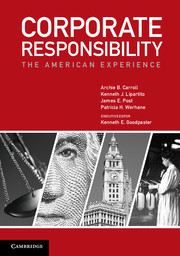Book contents
- Frontmatter
- Contents
- About the Authors
- Foreword
- Preface
- Introduction The Corporation in the Public Square
- Part I The Seeds of Corporate Responsibility
- Part II Corporate Responsibility Comes of Age
- Part III Taking Account of Corporate Responsibility
- Chapter 9 Stakeholders and Stockholders (1981–1989)
- Chapter 10 Corporate Responsibility Institutionalizes and Globalizes (1989–2001)
- Chapter 11 A New Social Contract for the Twenty-first Century (2001–2011)
- Conclusion Patterns and Prospects
- Endnotes
- References
- List of Plates
- Index
- Plate section
Chapter 9 - Stakeholders and Stockholders (1981–1989)
Published online by Cambridge University Press: 05 November 2012
- Frontmatter
- Contents
- About the Authors
- Foreword
- Preface
- Introduction The Corporation in the Public Square
- Part I The Seeds of Corporate Responsibility
- Part II Corporate Responsibility Comes of Age
- Part III Taking Account of Corporate Responsibility
- Chapter 9 Stakeholders and Stockholders (1981–1989)
- Chapter 10 Corporate Responsibility Institutionalizes and Globalizes (1989–2001)
- Chapter 11 A New Social Contract for the Twenty-first Century (2001–2011)
- Conclusion Patterns and Prospects
- Endnotes
- References
- List of Plates
- Index
- Plate section
Summary
The concept of corporate social responsibilty that had emerged from the turmoil of the 1960s, and became accepted as a cost of doing business in the 1970s – even as corporations faced serious economic challenges and greater public distrust – took on a new shape in the 1980s. During the decade, two paradigms of corporate responsibility – the stakeholder model and the classic ownership, or shareholder, model – clashed. Each provided very different answers to the questions of to whom, for what, and how to meet corporate reponsibility mandates. A strong backlash against government regulation and the election of Republican Ronald Reagan to the White House brought a political liberation of business from the regulatory and cost pressures of the social movements (civil rights, women's rights, environmentalism). By the end of the decade, the pressure to prioritize responsibilty to shareholders, over a broader set of stakeholders, had gained ground. Economic pressures, posed in part by global competitors and the threat of takeovers, had forced a new discipline on corporate social responsibility programs.
Business led the way in turning the conversation around to a different set of expectations of corporate behavior. Business leaders had come to understand that just as business activities must make social sense, social activities must make business sense. Corporate managers spoke of “strategic” philanthropy and social responsiveness. Companies offered a new rationale for public involvement: Charitable purposes could be advanced, alongside economic purposes, as with cause-related marketing. As one executive noted, “the key is to run corporate reponsibility like the rest of your business. The corporate responsibility plan must relate to the business plan.”
- Type
- Chapter
- Information
- Corporate ResponsibilityThe American Experience, pp. 303 - 336Publisher: Cambridge University PressPrint publication year: 2012

